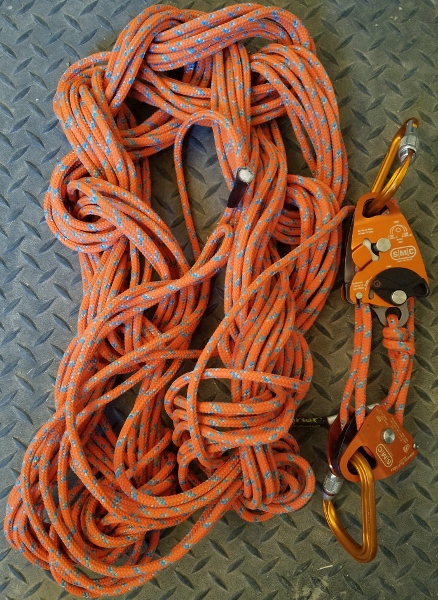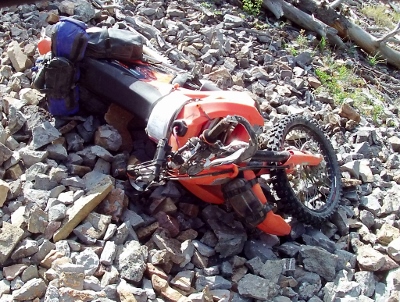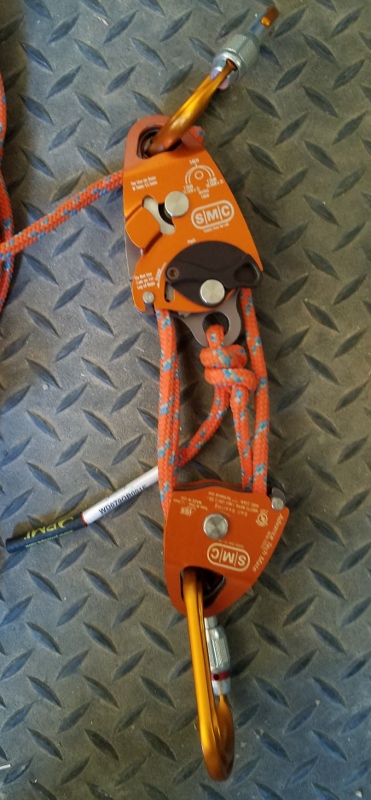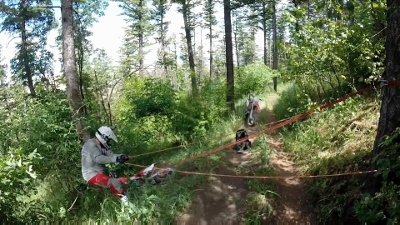| Home | Rides | Reviews | Bikes | Gallery | Tech | Misc | Contact |
| Dirt
Bike Self-Rescue Kit You'll know why you spent the $$$ the first time you need it. by Martin Hackworth Photos: Martin Hackworth, Mike Nellis, JR Hackworth |
 |
|
|
 |
It
happens in an instant. You are cruising along your
favorite
single track in the mountains or down by a stream when you clip a rock
or log and the next thing you know you and your bike are 20
feet
off the trail down in the brush, or worse in the water. On The Tour
of Idaho, known by some as the
Tour of Side Hill, this is
unfortunately a fairly regular occurrence. If you are in a group when this happens it's generally possible to grunt, groan, heave and moan enough to get a bike righted and back up on the trail with lots of bodies and sheer effort. I have, however, heard of this taking hours even with some pretty burly riders putting their backs into it. Most dirt bikes weigh somewhere north of 250 lbs loaded and that's a lot to heft up a steep incline through brush and/or rock. Often that's not possible even with a lot of muscle. A very common outcome of tossing one's bike off a side hill is having to ride or push the bike through the rough parallel to the trail until a way back presents itself. |
| Most
trail riders of my acquaintance carry at least a few
straps for various purposes including tugging on downed bikes and
towing other bikes when necessary. Add to that a couple of pulleys, a
few carabiners and 100' or more of medium-diameter climbing cord and
you have the beginnings of a rudimentary bike self-rescue
system. Having spent many years in the mountains as a climber I am painfully aware of the difference between a great concept and it's execution. Though it is entirely possible to source and assemble a rudimentary self-rescue system with items readily available at the local outdoor store a much better option is to purchase a kit specially made for the purpose, dirt bike rescue, from folks who have the experience and know how to put something like this together with the best materials for the job. Enter Cascade Rescue and their customized bike rescue kit. The difference in power for the task generated between this kit and something that you cobbled together yourself is roughly akin to a naked man vs. a freight train. Dana Jordan, owner of Cascade Rescue, assembles kits to spec as requested by customers. You may, however, ask him for the kit recommended by MotorcycleJazz for the Tour of Idaho (pictured). You'll get a setup containing two locking carabiners, two SMC rescue pulleys (one a cam-locker) and 150' of ~7 mm cord. You can get by with a lot less cord lengthwise but I would suggest not going much skinnier that 7mm. See our bike self-rescue video to see how it all works. Under most circumstances it takes far longer to get the system out of it's storage bag, deployed and then back into it's storage bag than it does to recover the bike. Your only decision with this kit is which end to attach to the bike. It employs a 3:1 mechanical advantage if used in the manner shown in the video, i.e. the locking pulley (above in the photo) is attached to anchor, the other pulley is attached to the bike and you pulling down. In this configuration you pull three times a much cord through the system as the distance the bike moves but with 1/3 of the effort of a straight pull. If you attach the locking pulley to the bike, the other end to the anchor and then pull up the mechanical advantage is 4:1. Whatever you do don't skimp on something like this (you'll rue the day when you have to use it). Especially don't skimp if you are contemplating a Tour of Idaho where the difference in getting your bike back on the trail quickly and with minimal expenditure of energy vs.grunt, groan, heave and moan, is huge. |
 |
 |
Cascade
Rescue
Kit Price: Basic kit $145.00, Pro Kit (the one used here) $285.00 The Good: You'll feel like Superman - really! The Rad: You'll feel much better looking down those side hills. The Gnarly: It hurts spending so much money on things that don't go braaapp until you use it. Our 13-minute Dirt Bike Self-Rescue. More Reviews Reader Forum |
| Home | Rides | Reviews | Bikes | Gallery | Tech | Misc | Contact |
